Choosing between group fitness classes and one-on-one personal training in Manhattan can feel overwhelming. There are so many options across the city.
Whether you’re eyeing a private trainer in Midtown or group classes on the Upper East Side, both paths come with their own perks. Each can help you chase down your fitness goals.
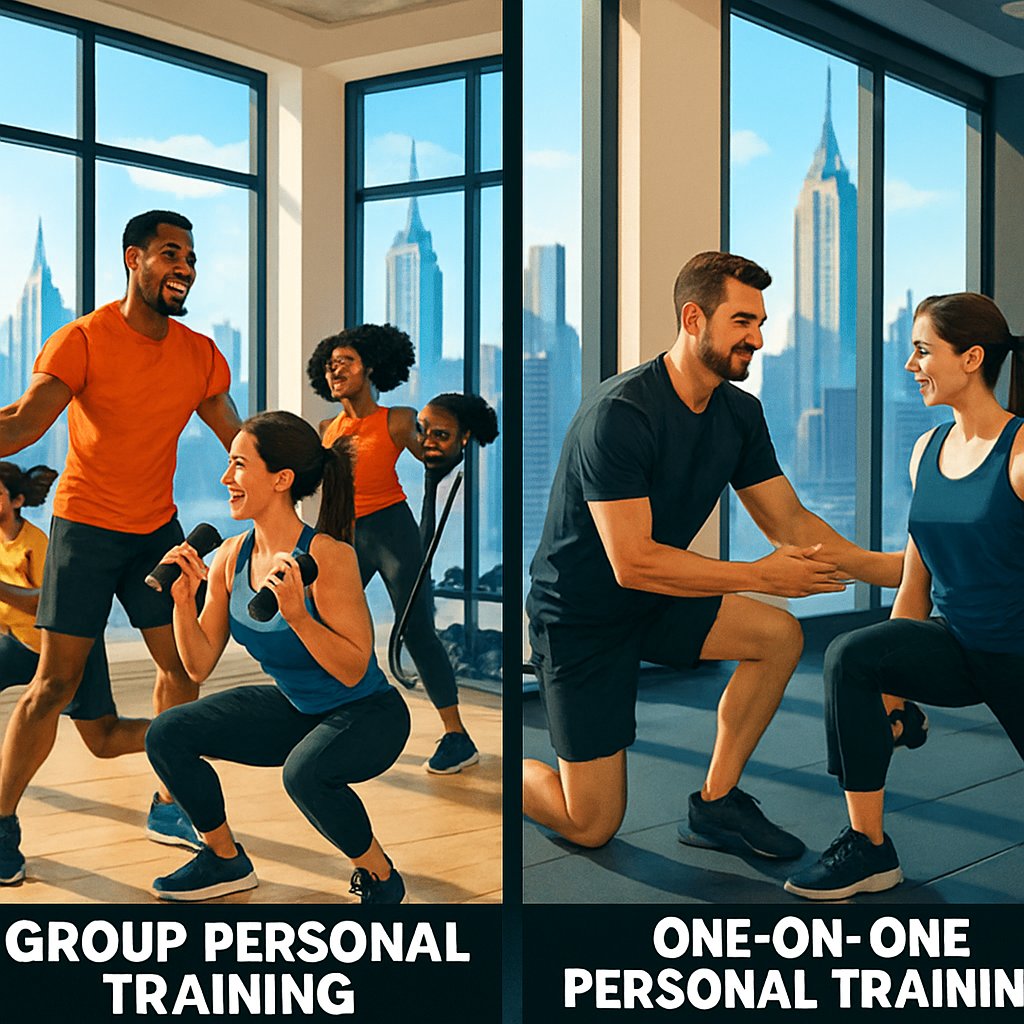
The best choice? It really depends on what you like, your budget, your current fitness level, and what you want to achieve.
One-on-one training gives you personalized attention and workouts tailored just for you. Group fitness, on the other hand, brings that extra motivation from being around others and usually costs less per session.
Manhattan’s fitness scene is wild—boutique studios in the West Village, big gyms in Midtown, you name it.
If you know the pros and cons of each training method, you’ll have a much easier time deciding. Here’s a breakdown of both options—costs, benefits, and how to pick what fits your life in NYC.
Key Takeaways
- One-on-one training is all about you and your goals, but it’s pricier than group classes.
- Group fitness gives you that team vibe and saves cash, but you sacrifice some customization.
- Think about your budget, your goals, and whether you want personal attention or thrive off a group’s energy.
Key Differences Between Group and One-on-One Personal Training
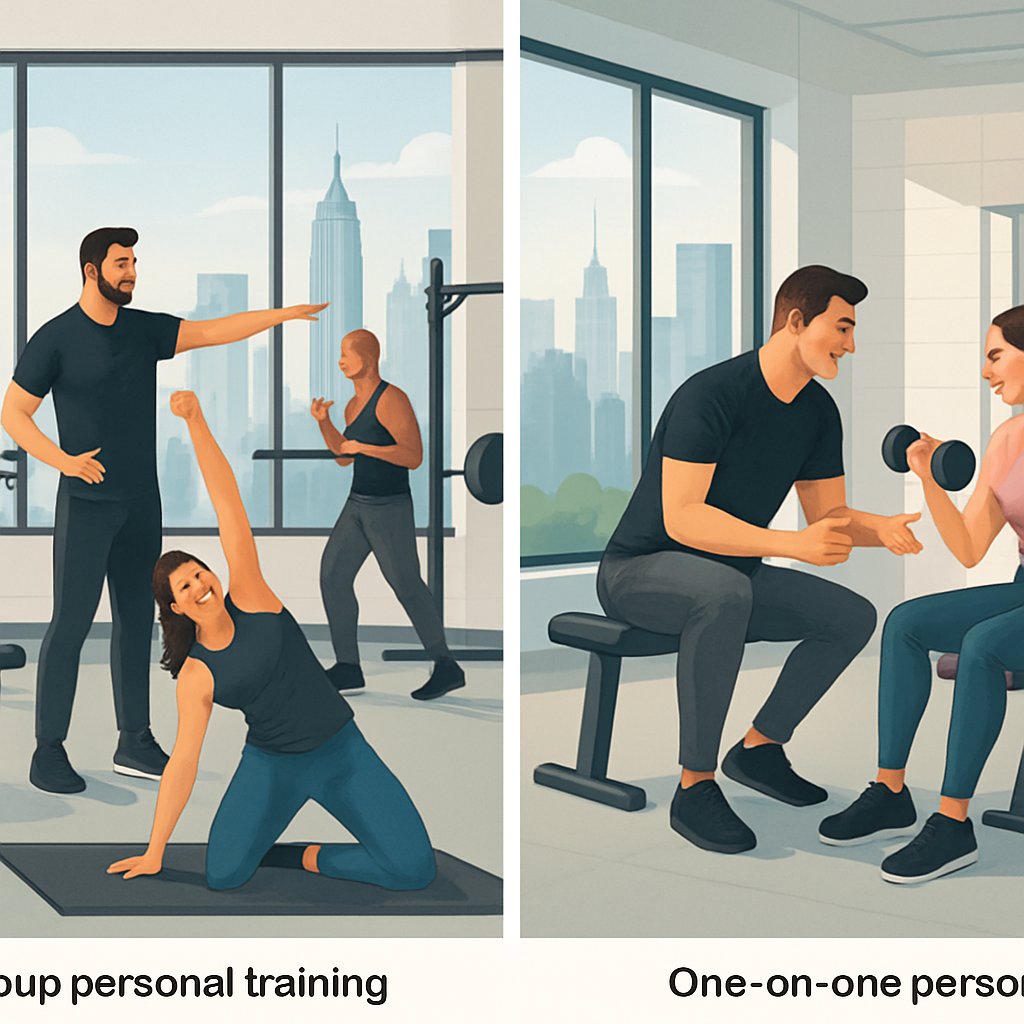
Group training and one-on-one personal training take very different approaches. They differ in how sessions are run, how much attention you get, and how personal the workouts feel.
Knowing the differences helps you pick what’ll actually work for you in Manhattan’s ultra-competitive fitness world.
Definitions and Overview of Training Styles
One-on-one personal training means you work just with your trainer for the whole session. You get their full attention, whether you’re at a Midtown gym or a cozy Upper East Side studio.
Your trainer focuses on your needs—your goals, your fitness level, and any quirks or injuries you might have.
Group training puts several people together with one or more instructors. Group fitness classes usually have 5-15 people all doing a similar routine.
You get a social vibe, working out with others. Manhattan group classes often use bigger studios so everyone fits safely.
The main thing? Trainer-to-client ratio. One-on-one is 1:1. Group sessions can go from 1:5 up to 1:15, depending on the class.
Comparison of Session Structure and Format
One-on-one sessions are super flexible. Your personal trainer in Midtown NYC can tweak exercises, rest, and intensity based on how you’re feeling that day.
Sessions usually run 45-60 minutes, with warm-up, workout, and cool-down. The structure bends to fit you.
Group classes stick to a set format and schedule. Most Manhattan studios run classes at fixed times, usually for 45-60 minutes.
Common group class formats:
- Circuit training at stations
- Synchronized moves led by the instructor
- Partner work with rotation
- Team challenges or friendly competition
The pace is set for everyone. Instructors can offer modifications, but they can’t totally rework the class for just one person.
Quick comparison:
| Aspect | One-on-One | Group Training |
|---|---|---|
| Flexibility | High – can change on the fly | Low – set format |
| Scheduling | Flexible appointments | Fixed class times |
| Workout pace | Matches your ability | Set for the group |
Individualized Attention and Personalized Programming
Individualized attention is where one-on-one training shines. Your personal trainer in West Village NYC watches your form and gives feedback instantly.
You get real-time tips for every move. Trainers spot problems early and adjust things like weights or form right away.
Personalized programming means your workouts are built for your goals. Want to lose weight, build muscle, or train for a marathon in Central Park? Your program shifts as your goals change.
Group training splits the instructor’s attention among everyone. In a 10-person class, you might only get a sliver of the coach’s focus.
Instructors give general cues and offer some modifications. They can’t make a unique plan for each person or watch your form the whole time.
Group fitness brings its own perks:
- Motivation from the crowd
- Social support and accountability
- Trying new exercises and styles
- That contagious group energy
The level of customization drops as the group gets bigger. Classes need to work for everyone, so programs get more generalized.
Pros and Cons of One-on-One Personal Training in Manhattan
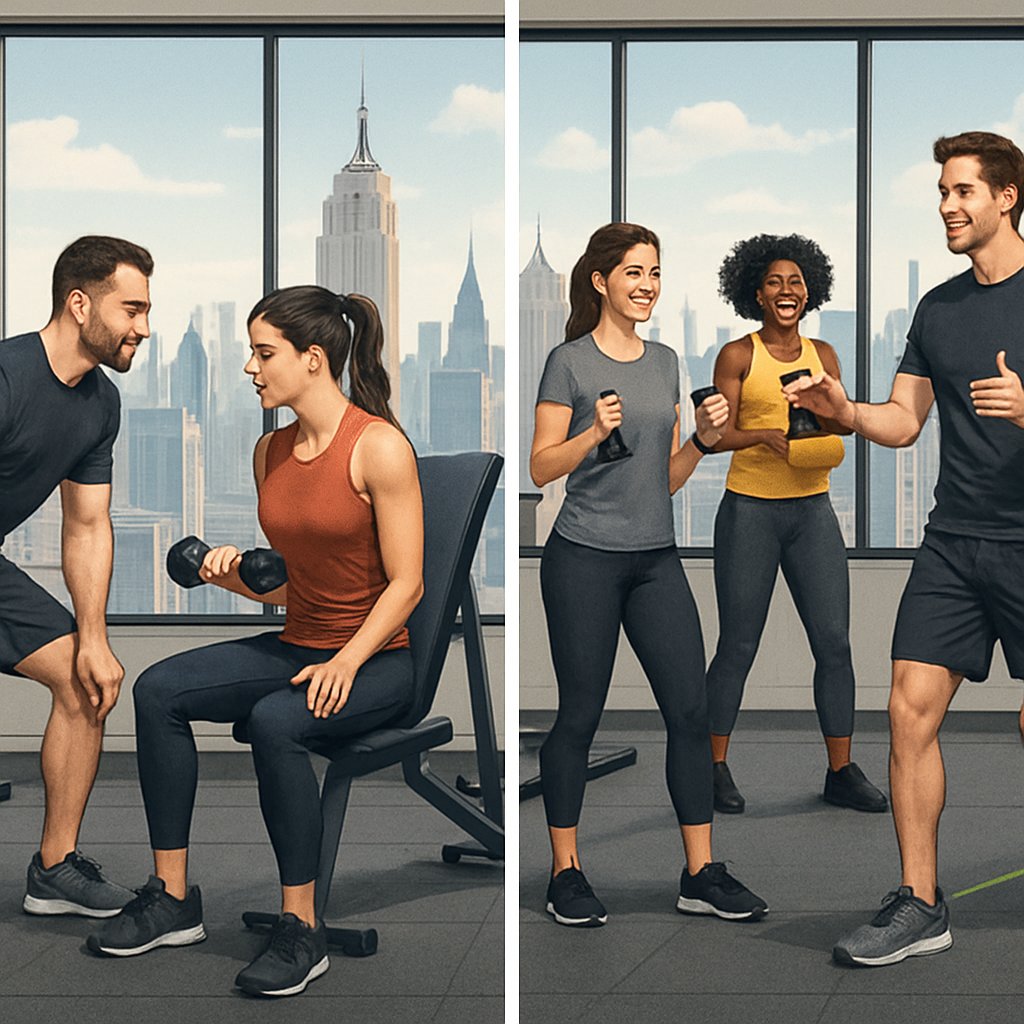
One-on-one training gives you personalized attention and tailored workouts that can really speed up your fitness journey. But private coaching isn’t cheap, and it’s not exactly a social event.
Advantages of Private Coaching
Personalized Attention and Customized Workouts
Your trainer zeroes in on your form, technique, and progress. This individualized attention helps you get the most out of every session.
Manhattan trainers build workout plans that match your goals. Whether it’s weight loss, muscle gain, or marathon prep, your routine is just for you.
Enhanced Safety and Supervision
Personal trainers keep an eye on your safety the whole time. They’ll spot you during heavy lifts and fix your form on the spot.
This matters even more in crowded Manhattan gyms. Your trainer keeps you safe, no matter how packed it gets.
Flexible Scheduling
NYC trainers often work with your crazy schedule. Need to squeeze in a session before your Wall Street shift? They’ll try to make it work.
Some trainers in the Upper East Side or Midtown even come to your apartment. That’s a huge time-saver.
Motivation and Accountability
Your trainer cheers you on and keeps you honest. They track your progress and push you when you’re tempted to slack.
In Manhattan, where work stress can easily derail your routine, that accountability is gold.
Potential Drawbacks
Higher Cost
One-on-one training costs more than group classes. Manhattan trainers often charge $100-200 per session—definitely an investment.
That price tag means most people do 1-2 sessions per week, not every day.
Limited Social Interaction
Private sessions don’t have that group buzz. You miss out on the shared motivation and camaraderie.
If you love working out with others, solo sessions might feel a bit lonely or intense.
Scheduling Dependency
Your workout hinges on your trainer’s schedule. If they get sick or cancel, your session is off.
Finding a backup in Manhattan isn’t always easy, especially if you’ve built a routine with one person.
Best Fit for Specific Fitness Goals
Injury Recovery and Medical Conditions
One-on-one is best if you’re bouncing back from an injury or need special attention. Trainers can tweak exercises to fit your needs.
Manhattan has plenty of trainers who specialize in post-therapy or medical fitness.
Specific Performance Goals
Private coaching is perfect for folks training for a competition or sport. Your trainer can build a plan for the exact skills you need.
New to Exercise
If you’re just starting out, personalized programs help you learn the ropes. Trainers teach you good form and build your confidence before you jump into group classes.
Time Constraints
Busy Manhattanites love one-on-one training because it packs a punch in less time. No waiting for others or adjusting to a group pace—every minute counts.
Trainers in places like West Village or Midtown totally get the city’s time crunch and design focused, efficient sessions.
Pros and Cons of Group Fitness Training in Manhattan
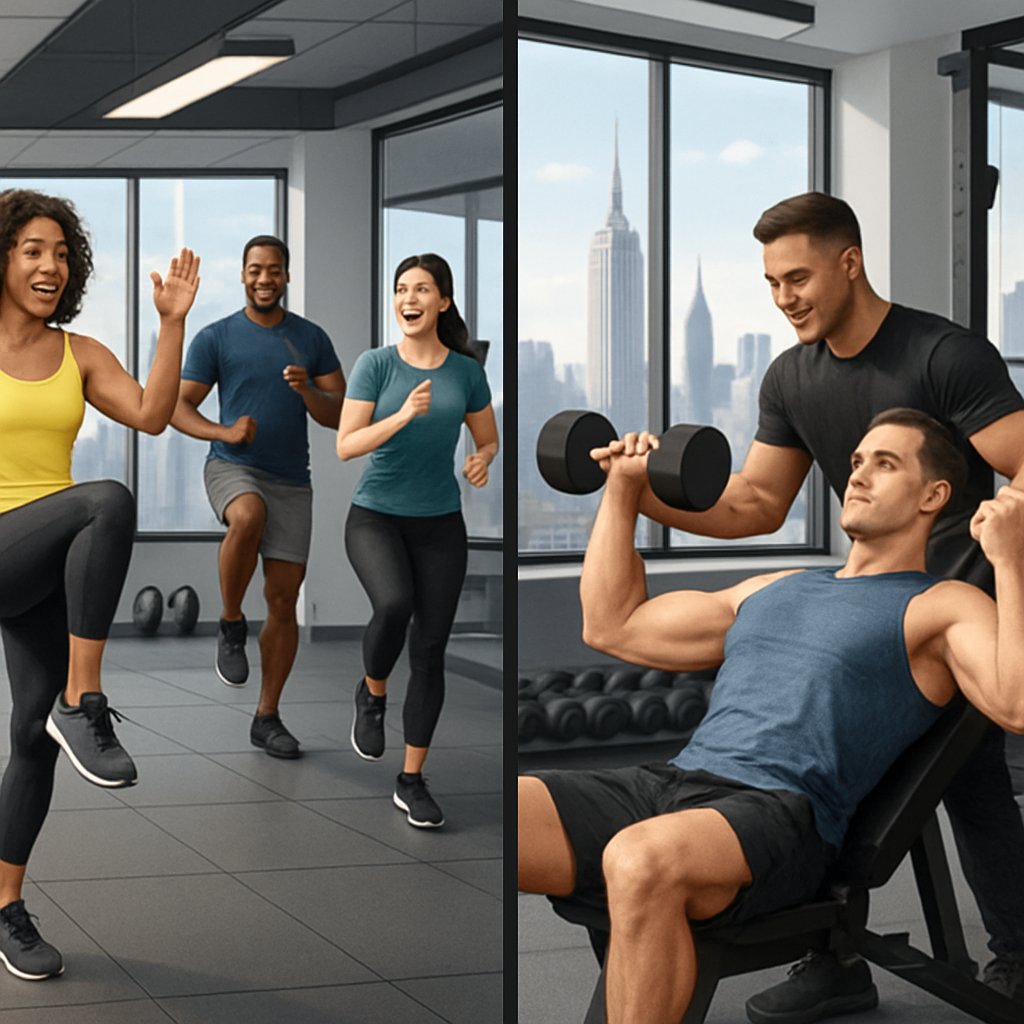
Group fitness training brings Manhattanites a social workout vibe, built-in motivation, and accountability. But it’s got its own downsides—like less personal attention and sometimes tricky scheduling.
Benefits of Group Exercise Settings
Group classes make it easier to stay on track. You’re surrounded by people with similar goals, and that energy is contagious.
Honestly, the buzz in Manhattan group classes can push you to work harder than you ever would alone.
Cost savings are a big plus. Group fitness is way more affordable than private sessions. Most gyms offer unlimited class packages that cost less than a couple of one-on-one sessions.
You also get variety. Try yoga one day, spinning the next, maybe HIIT on Friday. Mixing it up keeps things fresh and challenges your body in new ways.
The instructor takes care of the routine, so you don’t have to think about what to do next. That’s especially helpful if you’re new to working out.
Accountability comes naturally. When you skip class, your regulars notice. That little bit of peer pressure can keep you coming back.
Common Challenges of Group Workouts
You won’t get much personal attention. Instructors can’t watch everyone’s form in a packed Manhattan class.
Sometimes, technique problems slip by and could lead to injury.
Scheduling is another headache. Popular classes fill up fast, especially in busy areas like Midtown or the Upper East Side. You have to work around set class times instead of picking your own.
The class pace is set for everyone. Beginners might feel left behind, while advanced folks could get bored. The workout doesn’t really change for individual needs.
Intimidation is real. Some people feel awkward working out in front of a crowd. That self-consciousness can mess with your form and focus.
Manhattan studios can get cramped, too. Not enough space means you might not get your full range of motion.
When to Choose Group Training
Group fitness is perfect if you need that extra push from others or love a social vibe. If you’re more of a lone wolf, group classes might not be your thing.
On a tight budget? Group fitness is the obvious pick. Personal training in Manhattan is pricey, but group classes keep things affordable.
Go for group training if you want to mix up your routine. Different group fitness classes let you try new styles and target different muscles each week.
It’s great for people with flexible schedules who can make set class times. If your hours are all over the place, keeping up with group classes can get tricky.
Beginners benefit from the structure and guidance. Instructors show you the basics, and you can watch others for tips.
Group fitness works well for general goals like losing weight or boosting your cardio. If you need rehab or want sport-specific training, you’ll probably want more one-on-one attention.
How to Select the Right Training Approach for Your Needs
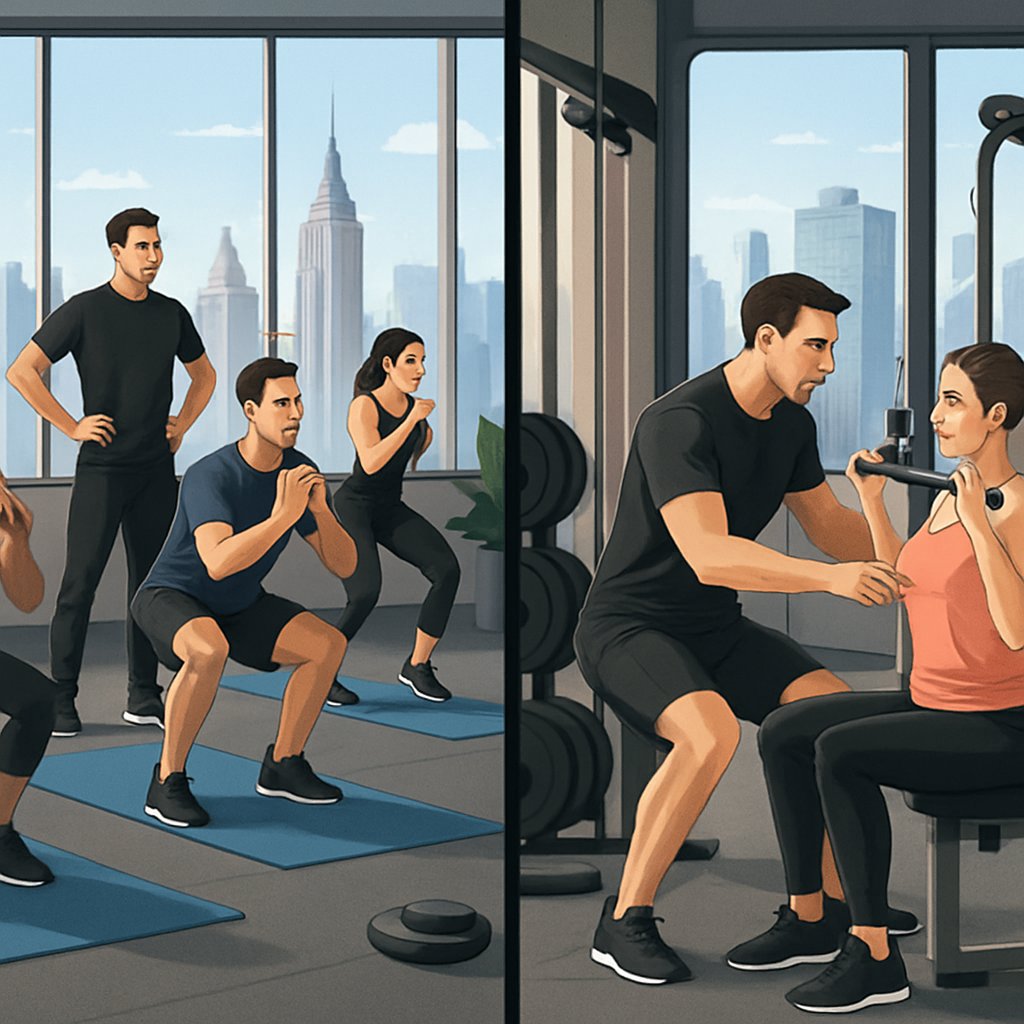
Your fitness approach should fit your personal goals, lifestyle, and how you like to learn. It really comes down to your fitness objectives, personality, budget, schedule, and whether you want social vibes or solo time during workouts.
Evaluating Your Fitness Goals and Personality
Your goals shape which training program works best. If you’re fixing movement patterns or bouncing back from an injury, one-on-one personal training gives you that laser-focused attention Manhattan’s busy scene can make tricky to find.
Goal-Based Selection:
- Weight loss: Group training brings motivation and accountability.
- Strength building: Personal training helps you nail form and progress safely.
- Sport-specific training: One-on-one sessions target your skills.
- General fitness: Either approach can work, honestly.
Personality matters more than people think. Introverts usually do well with personal trainers in quieter Upper East Side spots. If you’re outgoing, the buzz of group classes in Midtown might be more your thing.
Learning style? That’s another biggie. If you need thorough explanations and corrections, personal training is a good fit for analytical types. Prefer watching and learning from others? Group training gives you that plus some friendly competition.
Considering Budget, Schedule, and Social Preferences
Money talks, especially in NYC. Personal training in Manhattan usually runs $100-200 per session. Group classes are way easier on your wallet, about $30-60 each.
Cost Comparison:
- Personal training: $400-800 a month (2 sessions/week).
- Group training: $120-240 a month (2 sessions/week).
- Small group training: $200-400 a month (2-4 people).
Your schedule can make or break your routine. Personal trainers often flex with early mornings or late nights. Group classes stick to a set timetable, and that’s not always easy if your job’s unpredictable.
Social preferences play a bigger role than you might expect. If you love meeting new people, West Village group classes are packed with energy and community. If you’d rather keep things private, one-on-one sessions in Midtown let you focus without the crowd.
Making the Most of Your Training Program
Once you’ve picked your path, make it count. Prep matters, and so does clear communication. Share your goals and any limits with your trainer or instructor right from the start.
Preparation Tips:
- Jot down your goals—make ’em specific and measurable.
- Track your progress every week.
- Speak up about injuries or concerns as soon as they pop up.
- Arrive a few minutes early to settle in.
Consistency beats intensity, hands down. Whether you’re doing personal or group training, showing up regularly does more for you than the occasional all-out effort. Manhattan life gets wild, so skipping workouts is tempting—but stick with it.
Check in on your progress every month. If things aren’t clicking, don’t be afraid to change it up. Some folks start with personal training to get the basics, then switch to group classes for motivation and savings. Mixing both isn’t uncommon, especially as your needs shift.
Frequently Asked Questions

Manhattan fitness fans ask a lot about choosing between solo and group training. Most questions boil down to cost, motivation, and what actually works best for hitting your goals in NYC.
What are the benefits of one-on-one personal training compared to group training?
One-on-one personal training means you get customized attention and programs tailored to your level and goals. Your Manhattan trainer can focus on your form and progress without splitting their energy.
You get instant feedback and corrections. That’s huge for fixing weaknesses or working around injuries.
Personal training gives you individualized support and quick exercise tweaks if something doesn’t feel right. Trainers can adjust moves on the fly if you’re uncomfortable or just plain tired.
Privacy’s another plus. You can tackle personal goals without worrying about what others think.
How does group training impact motivation and accountability?
Group fitness classes bring a social boost. Working out with others in Manhattan studios often pushes you to go harder than you might solo.
Having a set class time helps you build routine and accountability. Honestly, it’s easier to show up when people expect you there.
The group energy makes tough workouts feel less intimidating. When everyone’s grinding, it’s easier to keep going.
But if your group’s not consistent, motivation can drop. If people skip a lot, you might lose your own momentum.
What are the primary disadvantages of one-on-one personal training?
Cost is the big downside. Manhattan trainers usually charge $80-150 an hour, so regular sessions add up fast.
Personality clashes can make things awkward. If you and your trainer don’t click, an hour can feel endless.
You’ll miss out on that group camaraderie. Some folks find solo sessions a bit isolating.
Scheduling can get tricky, too. You need to match up with your trainer’s calendar, which isn’t always easy in a busy city.
How do the costs of group training and personal training in Manhattan typically compare?
Personal training in Manhattan usually runs $80-150 per hour with seasoned trainers. Upper East Side and Midtown trainers often charge the most.
Group classes cost $25-40 per session at most studios. If you go for a monthly unlimited, the per-class price can drop to $15-25.
Small group training lets trainers help more people and brings down the cost for everyone. Semi-private sessions (2-3 people) usually land at $40-60 per person.
The price gap’s big—you could hit three or four group classes for the cost of one personal training session. Group training’s definitely easier on the budget for regulars.
In what ways can group training sessions be less effective than individual training sessions?
Group classes stick to a set routine, so they might not fit your exact needs. Instructors can’t tweak every exercise for each person.
With attention split among the group, you’ll get less feedback on form. That can mean bad habits or even injuries sneak in.
The pace usually matches the group’s average, not yours. Workouts can feel too easy or way too hard, depending on where you’re at.
Sharing equipment can be a pain, too. You might not get the right weights or modifications during strength segments.
How does the social aspect of group training affect the overall fitness experience?
Group fitness creates a sense of community that a lot of people find motivating and honestly, just more fun. Working out with others in Manhattan studios can make exercise feel way less like a chore.
Social connections in group classes sometimes go beyond the gym. Plenty of folks end up making friends who support them on their whole fitness journey.
The group environment can help beginners who feel intimidated by solo workouts. Seeing people at all different fitness levels is actually pretty encouraging.
Of course, some people get self-conscious or a bit too competitive in group settings. That can mess with their form or make them hesitate to modify exercises.
The social vibe can also get distracting and make it tough to focus on technique or push hard. Studios in the West Village and all over Manhattan try to strike a balance between fun social energy and actual fitness results.
